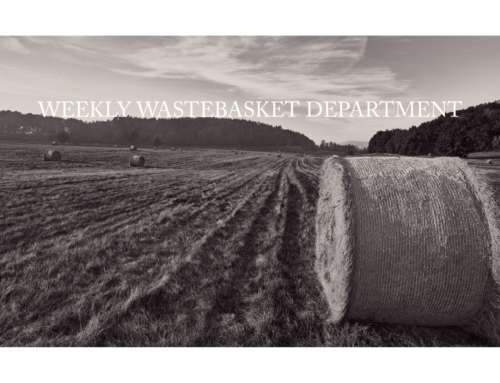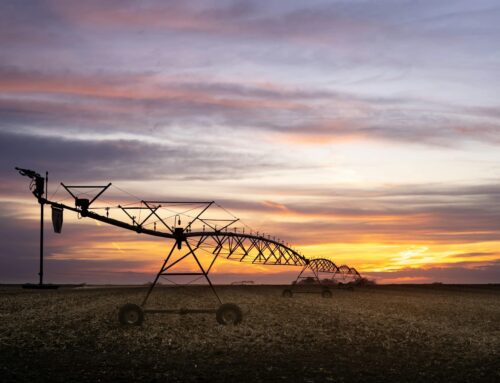The current federal financial safety net for agriculture is a complex web of overlapping and expensive subsidies that too often rewards a small number of special interests and large agribusinesses at the expense of taxpayers.
The federal government is currently projected to spend $14.5 billion a year on commodity and crop insurance programs that subsidize the incomes of agricultural businesses. In addition taxpayers spend $6 billion annually on agricultural conservation programs. Originally created to increase public goods such as clean water and clean air, agricultural conservation programs are increasingly targeted as a means to further subsidize agricultural business income often at the expense of the environmental goals.
With Congress laying the groundwork for a re-write of federal agriculture policy in an Omnibus Farm Bill, now is the time to begin reorienting Washington’s role in agriculture to better serve the interests of the entire agriculture sector, consumers that use agricultural goods, communities impacted by agricultural production, and federal taxpayers that are footing the bill. Congress and the administration must cast a critical eye on the performance of federal agriculture programs in wake of the 2014 farm bill. The goal must be to create a cost-effective, transparent safety net for agricultural producers that is responsive to current needs and conditions, and in which all parties are held accountable for producing results benefitting the public interest.
Principles for an Accountable Farm Safety Net
There is a federal role in agriculture. Rather than pick winners and losers based on political power, federal policy should create and maintain conditions where individual farm businesses are provided an opportunity to navigate markets based on their own perception of market needs and their individual ability. Federal policy should protect producers from catastrophic, systemic risks that individual businesses and the sector as a whole are incapable of managing while being flexible enough to allow businesses to adapt to changing markets. Agriculture policy must not devolve into parochialism at the expense of national interests. It also must not be tied to past challenges, but enable individual businesses and the sector to adapt to current and evolving needs.
Federal farm policy can also be designed to maximize public goods that absent federal programs would be unattainable, or less efficiently delivered. Agricultural producers are key partners in producing many valuable public goods including a dynamic and resilient food supply, clean water, breathable air, wildlife habitat, and recreational opportunities. Eliminating wasteful subsidies that encourage producers to take on more risk than they otherwise would is a major first step in the right direction. Federal dollars can also be marshalled to overcome technical or political barriers to realizing public goods. But federal programs must be able to clearly document performance. They also must be flexible enough to adjust to changing realities on the ground. Federal investments also require partnerships where all parties share in both risks and rewards.
In an increasingly globalized, consumer-oriented, and technology-driven 21st century economy, federal agriculture policy must adapt. Following are four common sense principles that should guide development of an improved financial safety net for agriculture that costs less, increases the resilience of individual producers and better serves the agriculture sector:
1) Cost-effective
Government assistance must be in line with what taxpayers can afford. With a $20 trillion debt, increasing annual deficits, and demographic changes contributing to significant fiscal strains on the horizon, federal spending must be prioritized on programs that are critical to public well-being. Spending also must be done in a manner that maximizes public returns on investment. Taxpayers simply can’t afford to say no to no one. In a time of rising deficits, every dollar spent on one program is a dollar not spent achieving another public good, or if added to the deficit, that limits future investments in public goods.
Agricultural Income Subsidy Programs Can’t Be Limitless
Agricultural business income entitlement programs created in the 2014 farm bill are vastly over budget, eliminating the billions in savings backers of the 2014 farm bill promised. All federal programs must be held accountable for cost overruns. Lawmakers need to ensure the agriculture committees produce the budget savings that were promised from reforming programs that constitute the financial safety net for production agriculture. Savings must come from the commodity and crop insurance programs and not at the expense of nutrition and conservation programs that are already exceeding their savings targets.
– Harvesting Taxpayer Cash (March 2017)
– Agriculture Committees Harvesting SNAP Savings to Feed Agribusiness (March 2017)
– Infographic on the 2014 Farm Bill (October 2016)
Help only those that need help through effective means-testing and payment limits
To ensure resources are efficiently deployed only where needed, means-testing and payment limits exist in every non-agricultural income entitlement program. In the farm bill, Title 1 commodity, conservation, and nutrition programs are all subject to forms of means-testing and payment limits. Federally subsidized crop insurance is the only agricultural income entitlement program not subject to these common sense measures. In applying these means-tests and limits, lawmakers should also implement stronger common sense eligibility requirements to ensure that only individuals actively engaged in farming and ranching are receive. The Government Accountability Office has repeatedly found that enacting effectively enforced limits on the amount of subsidies each producer receives annually will save taxpayers billions of dollars while only affecting the top few percent of producers (usually the largest and wealthiest).[1]
– Support H.R. 2332 Assisting Family Farmers through Insurance Reform Measures Act (AFFIRM)
– Support eliminating taxpayer subsidies for Harvest Price Option (HPO) polices by adopting H.R. 892 The Harvest Price Subsidy Reduction Act introduced by Rep. Duncan (R-TN), and its companion S.463 sponsored by Senator Flake (R-AZ) (114th Congress)
Allow agribusinesses to manage risks they are capable of managing
Agricultural businesses have many time-tested means of managing risk. Taxpayers cannot afford to shoulder the responsibility for managing normal business risks or guarantee high government-set crop prices that encourage farmers to plant for Washington instead of the market. The federal safety net should be concentrated on deep, catastrophic losses the sector is incapable of protecting against.
– Federal-Free Risk Management in Agriculture (June 2012)
– Shallow Loss Agricultural Programs 101 (August 2015)
Utilize market forces, rather than governmental mandates when feasible
Well-run markets are the most efficient means of distributing resources and providing public goods. The federal government should work to eliminate market distorting barriers, both foreign and domestic, that prevent agricultural businesses from effectively competing in the market. Government programs should also seek to improve government programs by injecting market principles, such as transparency and competition, when feasible.
– Crop Insurance and Private Sector Delivery: Reassessing the Public-Private Partnership (December 2016)
Encourage improved risk management, not irresponsible risk-shifting
Federal agricultural policies should increase the resilience of individual producers and the sector to financial and production volatility. Federal policies should not encourage irresponsible risk taking.
A number of reform options exist that will provide a viable financial safety net for agricultural businesses while not inducing overly risky behavior that impose significant costs on taxpayers, consumers, and the environment.
2) Transparent
Transparency is a fundamental tenant of democracy and good governance. Taxpayers deserve to know where their tax dollars are directed and the beneficiaries of these programs. Public disclosure helps prevent waste, fraud, and abuse.
Make agricultural subsidy programs transparent
At one point or another, all taxpayer subsidies have been shielded from the public eye. It’s time all subsidies – including highly subsidized crop insurance premiums – became transparent and available in an easily accessible and understandable format. Additionally, public comment and increased transparency should be required on all changes or additions to federal subsidy programs such as crop insurance so future expenditures can be scrutinized in the light of day instead of backroom-brokered deals. If agribusinesses object to the public’s right-to-know, they can turn down federal subsidies and instead utilize unsubsidized risk management options.
– Support H.R. 2332 Assisting Family Farmers through Insurance Reform Measures Act (AFFIRM)
– Web of Special Interests Influencing New Taxpayer-Subsidized Crop Insurance Policies (March, 2014)
Measure and communicate benefits produced from federal programs
The $20 billion a-year taxpayers spend on agricultural income subsidy and conservation programs is a significant investment. Taxpayers must have confidence this investment produces significant returns of vital public goods. Faith based budgeting is inadequate. Program impacts must be measureable to ensure resources are efficiently spent and any programs that fall short of desired impacts are improved.
– How to Increase the Benefits from Federal Agricultural Conservation Programs (October 2016)
– Benefits of Measuring Federal Agricultural Conservation Programs (August, 2016)
Increase communication and collaboration within USDA and across the government.
The USDA has a presence in nearly every corner of the country. Most agricultural programs involve partnerships with other levels of government, conservation districts, individual producers, nonprofit public service organizations, and other partners. Through better reporting, lessons learned from both successes and failures need to be shared within and across agencies, with project partners, and the biggest investor in these programs (taxpayers).
3) Responsive
The current maze of agricultural subsidies is the result of layer after layer of programs adding on top of each other. Too often the agriculture committees and special interests create new programs to address current needs while seldom reevaluating if legacy programs are still needed. In addition farm bill and annual appropriations debates make it clear the goal of many special interest advocates is to preserve political clout and levels of spending rather than produce a more effective safety net.
Evaluate programs based on impacts not simply dollars spent
Agricultural safety net programs must be evaluated on their ability to achieve results. Too often agricultural special interests evaluate success of as whether programs cost at least as much as predicted. The goal of farm policy must not be to maintain and increase spending, but to ensure that spending effectively achieves intended results.
– House Agriculture Committee Looks to Milk Taxpayers
– Crop Insurance Companies Cry for Cash
Evaluate agricultural income safety net, nutrition safety net, and conservation programs independent of each other.
The breadth of programs authorized under farm bills has more to do with historical accident and political convenience, than good public policy. The federal financial safety net for production agriculture and the nutrition safety net must be evaluated independent of each other. The reality is farm bills are zero-sum games, meaning any additional investment in one aspect will occur at the expense of another aspect. Experience shows conservation and nutrition programs are repeatedly used as foils to prevent common sense reforms to agricultural business income entitlements. Taxpayers deserve a robust debate on the goals, financing, and effectiveness of the nutrition safety net. They also deserve a robust debate on the goals, financing, and effectiveness of the safety net for production agriculture. They do not need a debate that pits one against the other.
– Agriculture Committees Harvesting SNAP Savings to Feed Agribusiness
– Impact of Federal Budget Gimmicks: Changes in Mandatory Program Spending (ChIMPS)
Make agriculture responsive to current needs by repealing permanent farm bill law:
Agriculture policy should not be based on outdated policies developed during the Great Depression that no longer meets modern needs. Keeping permanent law in place serves one purpose: forcing lawmakers to choose bad policies over disastrous ones. This cynicism must end if we ever hope to achieve a more effective and efficient farm safety net that limits taxpayer expenditures and excessive risk taking.
(4) Accountable
All parties involved in federal programs must be invested in achieving success. Policymakers that authorize initiatives, civil servants implementing programs, and direct beneficiaries of federal spending all must be held accountable for ensuring federal tax dollars are effectively managed in ways promoting national rather than parochial interests. In addition, federal subsidies are a two-way street. The public must ensure they get a positive return for such a significant investment.
Avoid cross-subsidies and minimize harms
Federal agricultural policy, especially income subsidy programs, contribute to a number of negative impacts. Policymakers must seek to minimize the occurrence of these impacts that impose significant costs on taxpayers and can detract from other public policy goals.
– Benefits of Strengthening Agriculture Conservation Compliance Standards
– Addressing Risk In Agriculture–Section 2: Subsidies to Address Risk are Harmful (Sept, 2016)
Ensure federal agricultural programs produce a significant return on investment –
Farm bills tend to be zero-sum, meaning investments in one program come at the expense of other programs. The issue is broader than the brinksmanship of parliamentary budget games. In a time of rising deficits, every dollar spent on one program is a dollar not spent achieving another public good or, if added to the deficit, that limits future investments in public goods. Must make tough decisions now. Taxpayers must be assured that programs receiving public investments are producing significant returns for the public.
– Fiscal Benefits of Measuring and Reporting Agricultural Conservation Program Outcomes (May 2017)
– How to Increase the Benefits from Federal Agricultural Conservation Programs (October 2016)
Eliminate crony capitalism and corporate welfare designed to line the pockets of special interests
A guiding principle of federal agriculture policy must be to create conditions that allows individuals to succeed based on their own merits rather than political power. Agriculture policy should be reformed to eliminate parochialism and favoritism of special interests. Taxpayers also deserve to know the lawmakers and special interests advocating for specific programs or carve-outs.
– Crop Insurance Companies Cry for Cash (March, 2017)
– Web of Special Interests Influencing New Taxpayers-Subsidized Crop Insurance Policies (March, 2014)
– Farm Bill Pet Projects (Jan, 2014)
Enforce and expand minimum accountability standards as a condition of program participation
The long history of voluntary conservation and federal financial safety net for agricultural businesses is predicated on an equal partnership between agricultural producers directly benefiting from the programs and taxpayers footing the bill. Taxpayers cannot afford to subsidize agricultural businesses without assurance these subsidized producers implement common sense conservation measures on highly erodible lands and wetlands.
– Fiscal Benefits of Measuring and Reporting Agriculture Conservation Program Outcomes
Conclusion
The time has come that U.S. agricultural policies become more cost-effective, transparent, responsive to current needs and accountable for their impacts.
Taxpayers and America’s farmers alike deserve an adequate, effective, and efficient agricultural safety net that limits unintended consequences, eliminates long-term liabilities, and allows private risk management options to compete on a level playing field. Producers should strive to operate under free markets that aren’t littered with unnecessary distortions and arbitrary, nontransparent special interest carve-outs that pick winners and losers.
Making federal agricultural policies more accountable to taxpayers and the public will not only save tens of billions of federal dollars, but will also reduce barriers for the next generation of farmers and promote a more resilient American agriculture.
[1] http://www.gao.gov/key_issues/farm_programs/issue_summary#t=1














Get Social